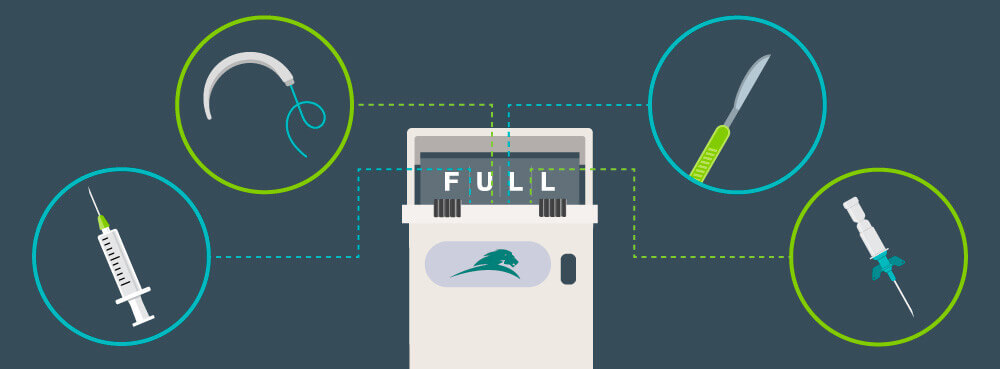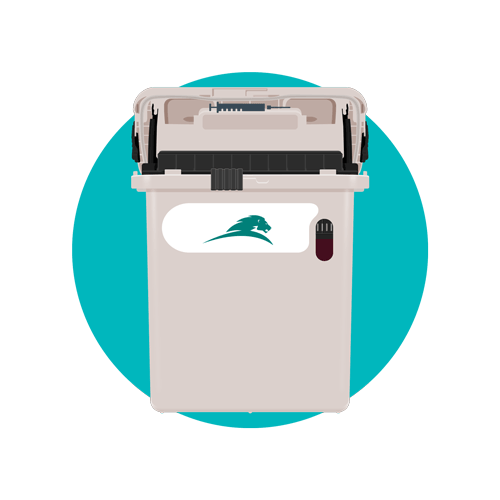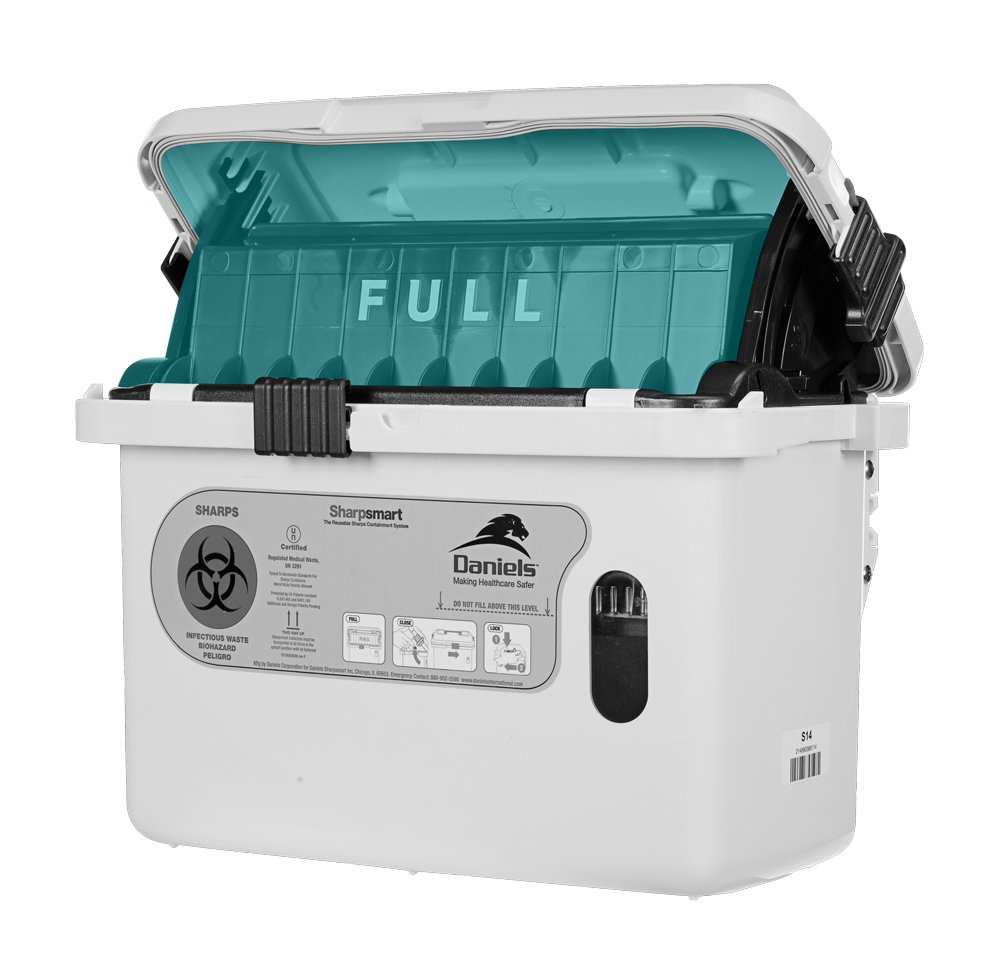How to Dispose of Sharps Waste

According to the Centers for Disease Control (CDC), roughly 385,000 needlestick or sharps injury-related injuries occur to hospital based healthcare workers every year. That’s just in the U.S. and doesn’t account for non-hospital incidents such as nursing homes, clinics, dialysis centers, veterinary facilities, or those that occur in home-based scenarios. Knowing how to properly dispose of sharps waste is essential for anyone working with ‘sharp objects’ within the healthcare industry.
Nearly every facility that uses medical tools or equipment like needles, syringes, scalpels, or even laboratory slides should be familiar with proper handling, segregation, and methods for dealing with sharps and other types of potentially infectious waste. Failing to do so not only exposes risks to healthcare workers, but to the general public.
Risks of improper sharps waste disposal
Know the rules for dealing with biohazard or biomedical waste management. Improperly disposing of sharps of any kind increases risk of contamination and/or transmission of a number of diseases that include:
- Hepatitis B (HBV) and C (HCV)
- Human immunodeficiency virus (HIV)
- Nearly 2 dozen additional pathogens, as well as bacteria, fungi, and other microorganisms that can include herpes, diphtheria, Staphylococcus aureus, and tuberculosis, just to name a few

According to recent data and based on workplace scenario, a needle contaminated with the hepatitis B virus can result in a 30% increased chance of infection for the person exposed though a sharps injury.
One of the primary reasons for needlestick injury scenarios are caused during or the disposal process. This is usually due to improper disposal behaviors. Other incidents during use include accessing IV lines, processing or transferring specimens, equipment, or when inserting or removing a needle during cleanup or recapping procedures. Some even occur while activating needle safety features.
Statistics regarding needlestick injuries and cuts or stabs caused by sharps are alarming. In one 2017 study, it was reported that hypodermic injections using disposable syringes and needles still continue to be one of the most prevalent causes of needlestick injuries. In the United States alone, approximately 35% of sharps (percutaneous) injection injuries are caused by disposable syringes. After that, needlestick injury sources continue to be patient rooms, recovery rooms, and operating rooms.
The types of sharps devices most commonly involved in sharps injuries include:
- Disposable syringes
- Suture needles
- Scalpel blades
- IV stylets
Resources to reduce Needlestick Injuries
Despite precautions, and even with leak-proof and puncture-proof sharps container use and proper sharps container placement, approximately 20% of needlestick injuries occurred during the disposal process or just afterward.
A number of resources emphasize instructions for sharps safety in both healthcare and home-based settings. For example, the Centers for Disease Control and Prevention (CDC), offers a number of teaching tools as well as a workbook for implementing processes to reduce sharps injuries and evaluating a sharps injury.
Refer to additional resources regarding the improvement of workplace safety for all employees working in healthcare scenarios by reviewing guidelines of documents found in:
- The Federal Needlestick Safety and Prevention Act (PL 106-430)
- The Occupational Safety and Health Administration (OSHA)
- The Center for Medicare and Medicaid services (CMS)
- State-specific legislation (via the national Institute for Occupational Safety and Health, providing state-by-state provisions of needle safety)
- Daniels Health Hierarchy of Sharps Injuries Controls
The CDC also offers a number of teaching tools, brochures and posters as well as information on using sharps with safety features.
Dealing with Sharps Disposal Regulations
Regulations regarding sharps waste disposal are clear and specific. A number of agencies and laws refer to compliant medical waste management across all waste stream categories. Details are found in regard to how to properly dispose of sharps waste. For example, the Code of Federal Regulations (49 CFR 173.134(a)(7) defines a sharp as “any object that may be contaminated with a pathogen and that are capable of cutting or penetrating skin or a packaging material.” The rule includes examples such as needles, scalpels, broken glass, culture dishes, and so forth.
49 CFR 173.197 specifies that “sharps are to be placed in containers that are rigid, leak resistant, impervious to moisture, strong enough to prevent tearing or bursting during normal conditions of transport, and puncture resistant for sharps and sharps with residual fluids.”
Another valuable resource for information on sharps disposal and handling is the Environmental Protection Agency’s Resource Conservation and Recovery Act (RCRA). Reference to additional information regarding the management of hazardous waste pharmaceuticals and proper pharmaceutical waste disposal should also be combined with needle safety and sharps safety practices.
Daniels Health understands that wading through pages of regulations can be daunting, but their importance cannot be oversimplified or underestimated. In the U.S. alone, treatments for needlestick injury to healthcare workers exceeds $1 billion annually. Studies have shown ever-increasing numbers of patients seeking healthcare services in clinics or doctors’ offices present with an infectious disease, increasing the risk of exposure due to carelessness, improper education, or improper biomedical waste management and disposal practices.
How to Prevent Needlestick Injuries
Preventing sharps injures in healthcare settings is a matter of education as well as a clear understanding of sharps safety features, and how to safely and accurately deploy those safety mechanisms. The CDC recommends anticipating the potential of injury when working with patients or in a work area such as the ER or during surgery. Increasing numbers of sharps devices including syringes that are equipped with safety features are being made available. However, healthcare workers must properly learn how to use the safety features on those devices. For one, safety features should be engaged immediately after use and prior to disposal.
Prevention of needlestick injuries means following guidelines not only for disposal, but use of proper sharps disposal containers. Several features must be included in using appropriate receptacles including:
- Functionality
- Visibility
- Accessibility
- Accommodation
Poster: Preventing Sharps Injuries
Sharps containers must be durable, not only during installation and use, but also during transport. Any sharps container should also be accessible, easy to operate, and prevent possible spilling.
 Containers should be placed at or below eye level. Compliant sharps container placement means away from doors and not under sinks or near a light switch, or any otherwise obstructed area. Containers should also be designed and placed so that fill status is easy to determine without touching, and of course, must be labeled appropriately.
Containers should be placed at or below eye level. Compliant sharps container placement means away from doors and not under sinks or near a light switch, or any otherwise obstructed area. Containers should also be designed and placed so that fill status is easy to determine without touching, and of course, must be labeled appropriately.
Last but not least, containers should facilitate minimal training requirements, be flexible in design, and easy to operate. Today’s sharps containers should accommodate one-handed disposal to reduce the risk of injuries.
Daniels Health is dedicated to not only reducing needlestick injury among healthcare personnel, but in providing compliant sharps containers to facilitate easy collection, handling, and transportation prior to ultimate disposal. For additional information on resources, education, and products that improve and enhance safety in the workplace, contact Daniels Health today.
Let's Talk!
Your time is valuable, and we don’t want to play hard to get. You can either phone us directly on the details listed on our contact page, or feel free to fill out this short form and one of our team members will get back to you as quickly as possible.
